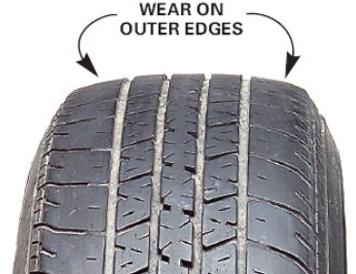What causes wear on the outside of front tires? Are front tyres wearing different treads? Why do front tires wear on the outside edge? What are the risks of front tires?
Front tires wearing on the outside edge is usually a result of aging coil springs.
As they lose height, so does the vehicle, causing the whole suspension to misalign, especially in camber. If the leaf springs are also sagging or wearing out, they cause caster misalignment, which may worsen the situation. Old front coil spring. Tyre wear on the outside edge could indicate something is wrong, such as: Under-inflation or leaks.
If your tyres are worn on the inside and outside edge, they could be under-inflated or leaking. This could cause the edges of your tyres to have more contact with the road than usual.
Taking corners too fast.
The inside edge, outside edge, or shoulder will show considerably more wear than the rest of the tyre. Source of issue Camber wear can be caused by: suspension misalignment, a bent strut, a dislocated strut tower, a weak or broken spring, a bent spindle, or collapsed or damaged control arm bushings.
Underinflated front vehicle tires can cause excessive or abnormal wear on the outside perimeter of the tires. Underinflated tires tend to fold inward towards the middle, a condition that causes the outside edges of the tires to press downward with abnormal force, which can cause excessive outside tire wear.
However, if the bottom of the tire is leaning to the outside, then you have negative camber. The negative camber is a leading cause of your car tire wearing on the inside. If outside edges of tyres are wearing on both edges equally then its your tyre pressure being too low – you’re getting a bowing of the central band of the tyre with less pressure being exerted. The outer edge of my front near side tyre seems to be wearing at a faster rate than the rest of the tyre.
Just wondered if this is a symptom of enthusiastic roundabout use, or could indicate a. One-sided shoulder tire wear : This type of irregular tread wear means the inside or outside shoulder rib of the tread is significantly more worn than the other ribs. Also known as camber wear, excessive positive or negative camber often causes this type of wear.
Around five months ago I noticed the outside edges of the front tyres were showing a lot of wear. The pressures are good so I suspected a tracking problem.
The car was taken to a local tyre dealer who I have used for years to have the tracking checked. When i bought my ASpecial Edition it came with tyres that where wearing on the outside edge of the front tyres.
The previous tyres that were on the front wore evenly.
One-sided wearwhen the top of the tire leans away from or toward the vehicle. This is your camber, and your wheels aren’t parallel.
When your tires are pointed toward or away from the roa there’s a problem with the toe and your vehicle isn’t set straight. There will be something wrong if wear is just on outside. Something is causing the front wheels to toe-in too much.
It may be bad adjustment OR wear in the control arm bushes etc. You need to get the all the bushes checked out first with no load on them.
The tyres seem to wear alot more excessively on the front tyres outer side. I think they may need changing already. I put it down to excessive speeds going around roundabouts as theres of the buggers each way from home to work all dual carriageways.
On my first FLI fitted General Grabber AT tyres, the two front tyres suffered from outside edge wear. The rear tyres have plenty of life left (4-5mm) however the front tyres are wearing unevenly.
The outer edges of the tyres are wearing faster than the rest of the tyre with the drivers side being the worse of the two. The centre of the tyres has approx 4mm left whilst the outer edge is approaching the limit. It looks like your running too much camber and thats worn the outside edge of the tire. No its not lowered.
However, Its significantly higher than standard for some reason. Pirelli tyres have been known to show more edge wear than other makes.



No comments:
Post a Comment
Note: only a member of this blog may post a comment.